
Viewfinder information shows HSS, flash confirm, wireless, active focus points, (continuous) focus confirmation, shutter speed, compensation, aperture, spot meter, and metering index.
© 2002 Bill Tuthill. All rights reserved. E-mail me.
If someone gave me the task of specifying the camera I wanted, my design would be much like this, but probably not as good. Minolta has taken almost all features a photographer could want, and packed them into the lightest, smallest possible package. Furthermore they have managed to create a user interface that is both easy to approach and comfortable to use over the long haul.
The Minolta 5 is all the film camera that most people need. As the smallest and lightest SLR ever manufactured, it is the most sensible body for travel where weight is a concern. Despite its budget price, the 5 is feature-rich and well-built. It offers accurate selectable-sensor autofocusing, quick film winding, predictable 14-segment honeycomb metering, depth of field preview, spot meter and spot autofocus, built-in flash, 16 settings to make the camera behave as you want, loads of easily accessed options, 5 specific subject programs, and a Panic button for returning to your defaults.
Autoexposure reached maturity over a decade ago, but autofocus continued to have its problems. High-end SLRs like the Nikon N100 and professional lenses like Canon USM telephotos provide fast and accurate autofocus, but often beyond the bounds of affordability. Maybe it's too soon to tell, but it appears that workable autofocus has now made its way onto budget SLR models. Below the 300mm focal length, I have no complaints about autofocus speed, control, or accuracy on my Minolta 5. The 5 can autofocus indoors with just the light of a 100 watt halogen or 20 watt fluorescent bulb.
Rather than merely list features, this section of the review traverses the camera from back to front.
The viewfinder shows a central cross-hair focus point, surrounded by spot metering area (the central honeycomb). Six other autofocus points are above and diagonally to the sides. Underneath is an extensive status display including exposure scale.
Back to Front

|
Although official Minolta information does not specify the correlation of 14-segment honeycomb metering with AF points, we think the arrangement looks like this example, where the upper-left AF point is lighted red to confirm focus, thereby moving the metering pattern leftward.
Viewfinder information shows HSS, flash confirm, wireless, active focus points, (continuous) focus confirmation, shutter speed, compensation, aperture, spot meter, and metering index. |
|
The on/off button is next to the viewfinder. Spot AF selects the central focus sensor, or can be used with the control wheel to select an AF point, clockwise or counterclockwise. The Spot(meter) doubles as a Slow Sync button when in flash mode. Also on the back are film window, rewind button, and open button. The back locks while the camera contains wound film.
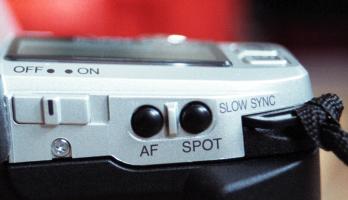
|
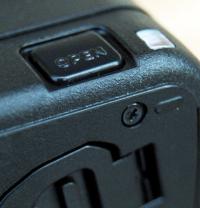
|
The function dial rotates forever in either direction. You change settings with the command wheel next to the shutter release (see pictures below).
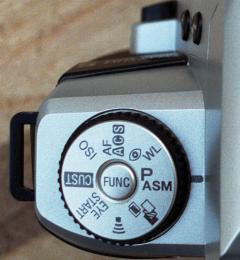
|
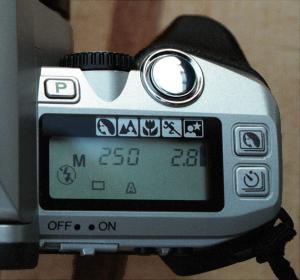
|
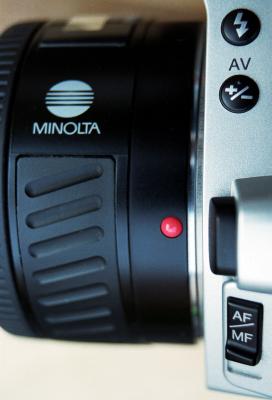
|
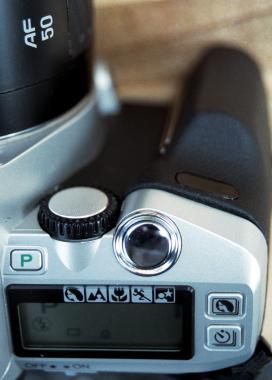
|
A model with quartz date imprinting and remote control is available outside the US, where this camera is sometimes called the Dynax 5. In Japan its brand name is the Alpha Sweet 2. BP-200, an AA battery-pack grip without controls, is an option for people with large hands. A cable release (RC1000 short or long) may be purchased for about $40.
It is amazing how many features Minolta managed to pack into such a small lightweight camera. Comparing by specifications, the 5 competes with advanced-amateur bodies from other vendors, in particular the Canon Elan 7 (EOS 33), Nikon N80 (F80), and Pentax 5N.
The Minolta user interface is clear and predictable. One thing I like better than on Canon models is that all features work in all modes. For example, flash override and continuous focus, among other things, can be separately controlled in Portrait, Landscape, Macro and Sports mode. On Canon bodies, the camera forces automation of these functions. If photographers trust Program mode, why shouldn't they also trust Portrait and Landscape to minimize and maximize depth of field?
According to Minolta the 5 has the fastest autofocus in its class, although it is unclear what they mean by class, and whether fast designates time lag from near to infinity, or ability to take the most pictures of a moving subject. Popular Photography tests indicate a 1/10 second delay between button-press and shutter movement, "typical of this class" they say. With 70-210/3.5-4.5 lens mounted, I can continuously zoom-frame a car driving down a city street with perceptible hesitation for refocusing just when the car passes, capturing 38 images in 18.06 seconds for an average rate of 2.1 frames/second.
The model that the 5 replaced, the HTsi/XTsi/505si, had more of a protrusion below the shutter release, making it easier to grip and more comfortable to rest on your fingers.
Rear-curtain flash could be added to the Eyeball/WL menu without complicating the user interface. It would be nice to have flash compensation in addition to exposure compensation, but I'm not sure where it could be added without increasing complexity. Exposure compensation works OK as a substitute (note that wireless flash overexposes when subjects are closer than 1 meter).
Backlighting on the LCD would make this camera easier to use in the dark. The viewfinder on my sample is not precisely centered within its 90% area: it's a bit too high. I wish autobracketing went in order (-1 0 +1) instead of starting at zero, so bracketed slides on a lighttable could be compared more easily.
It would be nice to have depth-of-field readout, the ability to adjust aperture while pressing DOF preview, and a chart of 14-segment honeycomb metering values. These (and flash features) are good reasons for buying the Maxxum/Dynax 7. The 5 does support advanced distance integration (ADI), which is similar to Nikon D flash but works better.
The following sections compare competitive models.
The Minolta 5 shares body components and user interfaces with the Minolta 4, which is identical to the Minolta 3 sold in certain markets (such as Asia). However the Minolta 4 offers only three unlighted autofocus points, 1/2000 and 1/90 fastest shutter and sync speeds, no DOF preview, no eye start, 1.7 frames/second, and plastic lens mount. For a savings of only $40 and 15 grams, it hardly seems worth it.
Almost everything was dramatically improved. Autofocusing is far more decisive and film winding is 50% faster. The shutter is quieter, giving a sound impression of better quality. Autofocus sensors light up (with optional beep) to indicate focus point. The viewfinder information moved from left side to the bottom, where it is easier to see, and contains more items. The camera back locks to prevent accidental film exposure. It can be unlocked with a combination you'll never remember, or forced open with a lever using a small screwdriver. Metal lens mount and tripod screw promise greater longevity. Useful features like DOF preview, adjustable autobracketing, single-shot or continuous-focus selection, program shift, ADI flash, 4-segment flash metering, and eye start are provided for the first time. The Spot AF button was moved up next to the Spot Focus button in what appears to be a cost-cutting move, but in practice the new location is fine. The control wheel went from horizontal to vertical, making it easier to reach from the shutter. The auto/manual focus button is much easier to operate.
On the 505si, it was hard to select one of the 3 autofocus point: you had to set a custom function, which disabled easy spot focusing. On the 5, you can select autofocus point without customization: just press the AF button on the back and rotate the control wheel. This sensible design allows you to select central spot focus simply by not turning the control wheel.
The Minolta 5 isn't as quiet or as fast-winding as the Elan 7, but it provides most features except rear-curtain flash, flash exposure compensation, and mirror lockup. The Minolta 5 has much better low-light autofocus than the Elan 7, plus spot metering, lighter weight, and lower cost. There are aspects of the Elan 7 that I don't like, most notably the AF-point selection keypad being disabled by default, the many features that stop working in special program modes (flash control and multi-shot to name two), and autobracketing that doesn't pause after 3 shots.
The Minolta 5 has built-in wireless flash controller, high-speed flash sync (HSS) with accessory flash, more autofocus points, lighter weight, lower cost, offers special program modes, and can pull off 3 instead of 2.5 frames per second. But the Nikon 80 has wider viewfinder coverage, rear-curtain flash, flash exposure compensation, and a useful custom function to impose a grid in the viewfinder. Low-light autofocus on the two bodies is similarly excellent. I am a big fan of the Nikon 80, but the Minolta outspecs it in some ways.
The Pentax 5N has only 3 non-selectable autofocus points, the fastest shutter speed is 1/2000 not 1/4000 second, flash sync speed is only 1/100 not 1/125 second, and its motor winds at only 1.8 frames per second. The Pentax also lacks multiple exposure, special program modes, custom functions, and high-speed sync capability. On the plus side, the Pentax can do rear-curtain sync with accessory flash, and the viewfinder has diopter adjustment.
The Minolta 7 provides a handy graphic of 14-segment metering on the back, showing which segments are overexposed or underexposed, and by how much. It also offers a depth-of-field readout with D lenses, and you can adjust aperture while DOF preview is activated. The 7 offers 1/8000 top shutter speed, 1/200 flash sync, data memory, and full-time manual focus override for touch-ups. Rear-curtain flash and flash exposure compensation are provided. You can customize autobracketing order (for example dark to light). The 7's control layout is more old-fashioned (with knobs), which some folks prefer. However there is no Panic button, and no pre-set program modes, although users can configure 3 custom modes including exposure method and everything else.
The Minolta 9 professional body has the additional advantages of durability, MLU, fast frame rate, powerful AF motor, VC grip, PC flash connection, 100% viewfinder, and interchangeable focus screens.
Competitive pressures have led Canon, Minolta, and Nikon to deliver almost all important features in bodies costing less than a low-quality digital camera. So now, the main reasons for buying a professional SLR are durability and specialized features, and the main reason for going digital is immediacy.
The 5 with 24-105/3.5-4.5 D lens is a very capable combination, although in 2001 Minolta made no telezoom lenses with matching 62 filter thread. Minolta recently redesigned a 28-80/3.5-5.5 D with fewer elements and groups, probably for lower price, but optical quality also improved, and the lens did well in the Popular Photography February 2002 test. Minolta makes a 75-300/4.5-5.6 D with matching 55 filter thread that is sharp from 75-200 or so, but quite soft above that.
Alternatively, a Tamron 24-135/3.5-5.6 SP or used Minolta 28-135/4.0-4.5 could be combined with a Minolta 200/2.8 G (and optional teleconverters) or a Minolta 100-400/4.5-6.7 APO, because all accept size 72 filters.
What Was Done Well
What Could be Improved
Compared to Other Cameras
Compared to the Maxxum/Dynax 4 (3)
Compared to the Minolta HTsi (505si)
Compared to the Canon Elan 7 (EOS 33)
Compared to the Nikon N80 (F80)
Compared to the Pentax ZX-5n (MZ-5n)
Compared to the Maxxum/Dynax 7
Bottom Line